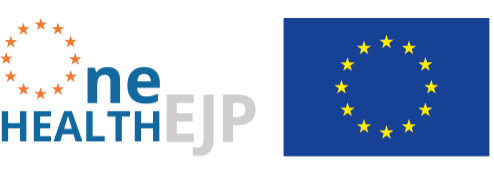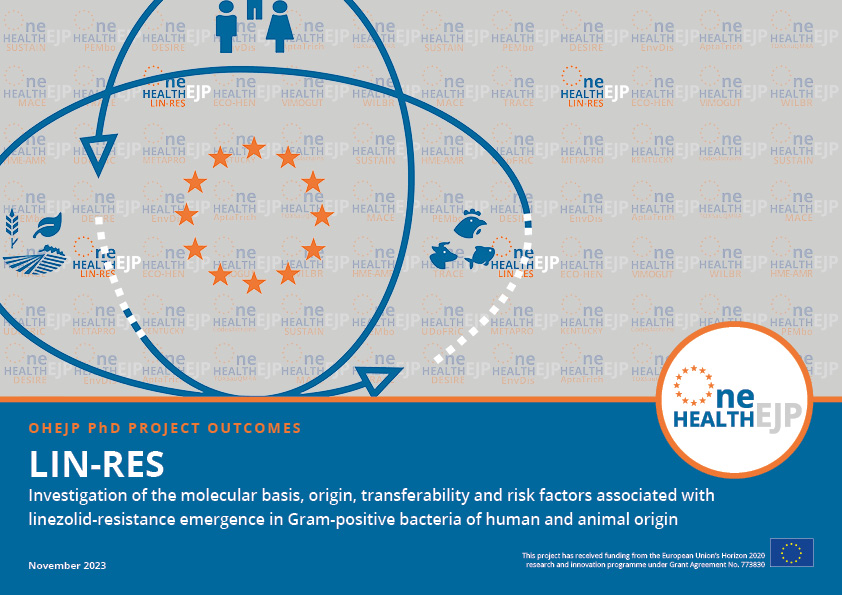Avenue Franklin Roosevelt 50, Charleroi, Wallonie, Belgium
Max-Dohrn-Straße, Berlin, Berlin, Germany
14 Rue Pierre et Marie Curie, Maisons-Alfort, Île-de-France, France
Rue Juliette Wytsman - Juliette Wytsmanstraat 14, Ixelles - Elsene, Région de Bruxelles-Capitale - Brussels Hoofdstedelijk Gewest, Belgium

The Project #LIN-RES
| Start: | 1 January 2019 |
| Duration: | 3 Years |
| Domain: | Antimicrobial Resistance |
| Members: | Sciensano- Belgium, ANSES- France, BfR- Germany |
| Contact: | Cecile Boland (Sciensano) & Thierry van den Berg (Sciensano) |
LIN-RES: Investigation of the molecular basis, origin, transferability and risk factors associated with linezolid-resistance emergence in Gram-positive bacteria of human and animal origin
Linezolid belongs to the oxazolidinone family of antimicrobials and is one of the last resort drug used to fight human infections caused by multi-resistant Gram-positive bacteria such as Streptococci, Staphylococci and Enterococci. It is commercially available since 2000 and has not been licensed for use in animals. In 2008, the first instance of transferable resistance to Linezolid caused by the 23SrRNA methylase Cfr (for Chloramphenicol Florfenicol Resistance) was reported in US Staphylococcal isolates recovered from human infection cases. optrA is another gene conferring resistance to Linezolid and Phenicols whose sequence was first reported in 2015. It consists in an ABC-type of membrane transporter and works as an efflux pump. After its initial finding in China, it recently emerged in animal and human Enterococci / Staphylococci on both the American and European continents.
Cfr not only confers resistance to oxazolidinones but also to pleuromutilins, streptogramins, lincosamids and phenicols. EU Staphylococcus isolates harboring cfr were described from 2011 onwards, mainly in intensive care units. In China, the cfr gene was first detected in a Bacillus sp. of animal origin in 2010 and soon after in Enterococci and Staphylococci.
Cfr emerged in EU livestock first in coagulase-negative Staphylococci and very recently in Methicillin Resistant Staphylococcus aureus (LA-MRSA) strains isolated from healthy pigs. Surprisingly, the cfr gene found in LA-MRSA was born on plasmids carrying a Tn558::cfr variant identical to the one found on a plasmid hosted in a hospital-acquired coagulase-negative Staphylococcus in Germany and hosting another resistance gene, fexA involved in resistance to fenicols. Plasmids and bacterial species hosting this Tn558:cfr variant are thus different, but the recombinant transposon-like elements are 100% identical at nucleotide level.
Acquisition of transferable resistance to Linezolid by Staphylococci hence seems to follow a reproducible scenario. The hallmark is a cfr- or optrA-embedded transposon variant carried on a plasmid roughly 40-kb in size and hosted in a Staphylococcus species under selective pressure in a given ecological system. The selective pressure is obviously the use of Linezolid itself in Hospitals / Intensive Care Units, but must be different when it comes to animals raised for food production. Though currently limited in terms of frequency, emergence of cfr in European LA-MRSA is most probably attributable to a selection mechanism driven by the veterinary use of antimicrobial molecules unrelated to Linezolid but acting in a similar way on the bacterial ribosome. The usual suspects are Florfenicol and Lincomycine, which are used to treat common bacterial infections in pigs including pneumonia and diarrhea. If raising continuously, the horizontal spread of cfr – or optrA-carrying transposons could on the long term compromize the success of (human) antimicrobial therapies aimed at fighting infections caused by Gram-positive organisms with last-resort molecules such oxazolidinones or last-generation pleuromutilins. The presence of optrA in livestock-associated gram-positive bacteria has mainly been reported in China (Guangdong province) so far but its emergence on other continents is just a matter of time.
This raised important questions that LIN-RES PhD project was to address:
- Are optrA– and cfr-carrying transposons horizontally transferred from humans to animals or the other way around, from animals to humans?
- Are peculiar transposon variants such as Tn558:cfr the unique source of cfr transmission or are there other genetic carriers of concern?
- What is the prevalence of these genes in Gram-positive indicator bacteria isolated from healthy animals in the EU?
- What are the risk factors favouring their dissemination?
LIN-RES project proposed to investigate the molecular basis, origin, transferability and risk factors associated with Linezolid-resistance emergence in Gram-positive bacteria of both human and animal origin.
In the beginning of the project, the aim was to collect resistant isolates from the Belgian antimicrobial resistance official monitoring. As the previous Belgian data showed few linezolid resistant bacteria through this non-selective monitoring, it was planned to compare WGS results between all isolates recovered from the different geographical origins.
In 2019 a linezolid selective monitoring was conducted in Belgium in food-producing animals: 139 samples were positive for linezolid resistant (LR) bacteria, more than estimated. The LR rate differed widely between animal host species, with the highest rates occurring in nasal samples from pigs and sows (25.7% and 20.5%, respectively) and faecal samples from veal calves (16.4%). All LR isolates recovered from the Belgian selective monitoring (n=147) and from Sciensano collection (n=3) or given by collaborators of the project (n=5) were sequenced by NGS to look for resistance determinants and determine the genetic context surrounding resistance genes. To do that, we developed a pipeline to analyse the NGS data. Most isolates (97.3%) carried one or more LR genes known to be transferable: optrA, poxtA and/or cfr. The most observed gene was optrA which gives only cross-resistance to phenicols, in addition to linezolid. Bacterial species was determined both by MALDI-TOF and Kraken and it revealed no correlation between bacteria and carried linezolid resistance determinants, except for Staphylococci in which only the cfr gene was found. The genetic context analysis revealed several genetic organisations surrounding linezolid resistance genes, especially for the optrA gene. Finally, phylogenomic analyses were carried out, showing no correlation between phylogeny and linezolid resistance determinants. NGS results showed that LR determinants are present in a large diversity of isolates circulating in the agricultural sector, with some isolates closely related to human isolates, posing a human health risk. More details are given in our publication (see publications section below).
The NGS data showed also that several incompatibility group markers were present among the isolates. Unfortunately, NGS data couldn’t allow us to determine for all isolates which marker was associated with which gene. We also proceed to transferability experiments. Unfortunately, no transconjugant was obtained while several experiments have been conducted. Based on our findings and the observed limitations of the design of our experiments, we cannot conclude whether or not the linezolid resistance genes of the selected donor candidates could be transferred. However, the results of this deliverable are useful to improve the design of future conjugation experiments.
Finally, a risk factors analysis based on epidemiological and consumption data has been conducted. This study explored putative risk factors for the occurrence of linezolid resistant bacteria (commensal Enterococci and Staphylococci) in faeces from veal calves, broilers, laying hens and pigs and in nasal swabs samples from pigs collected in 2019 in Belgium. The results of this study are available and will be published after the final reporting. As a conclusion, all main project objectives have been met and the expected deliverables have been sent.
Such scientific research and such selective monitoring are important to be continued and extended throughout Europe to ensure a good surveillance and understanding of the mechanisms and spread of resistance and to promote a prudent use of ALL antibiotics in a One Health perspective. The results of the LIN-RES project raised awareness about the issue related to the emergence of linezolid resistance and about cross-selection of critical resistance through the use of non-critical antibiotics like phenicols.
Congratulations to Michaël on being awarded his Doctorate degree in Spring 2022!
Project Assets
Timmermans, M., Bogaerts, B., Vanneste, K., De Keersmaecker, S. C. J., Roosens, N. H., Kowalewicz, C., Simon, G., Argudin, M. A., Deplano, A., Hallin, M., Wattiau, P., Fretin, D., Denis, O., & Boland, C. (2021). LIN-RES project: Genomic analysis of linezolid resistance in strains isolated from healthy animals and human patients. Poster presentation at One Health EJP ASM 2021, Copenhagen, Denmark. 9-11th June 2021. DOI: https://doi.org/10.5281/zenodo.6724771
Timmermans, M., Wattiau, P., Fretin, D., Grobbel, M., Granier, S., Broens, E., Denis, O., & Boland, C. (2020). LDZ-R project: Linezolid selective monitoring during 2019 in Belgium: a linezolid resistance study. Poster presentation at One Health EJP ASM 2020, Online. 27-29th May 2020. DOI: https://doi.org/10.5281/zenodo.6724563
Timmermans, M., Wattiau, P., Fretin, D., Grobbel, M., Granier, S., Broens, E., Argudin M. A., Denis, O., & Boland, C. (2019). Project “LIN-RES” Molecular basis, origin, transferability, and risk factors associated with linezolid-resistance in Gram-positive bacteria of human and animal origin. Poster presentation at One Health EJP ASM 2019, Dublin, Ireland. 22-24 May 2019. DOI: https://doi.org/10.5281/zenodo.6723515
Timmermans, M., Wattiau, P., Denis, O., & Boland, C. (2021). Colistin resistance genes mcr-1 to mcr-5, including a case of triple occurrence (mcr-1, -3 and -5), in Escherichia coli isolates from faeces of healthy pigs, cattle and poultry in Belgium, 2012-2016. International journal of antimicrobial agents. 57(6), 106350. DOI: https://doi.org/10.1016/j.ijantimicag.2021.106350
Timmermans M, Bogaerts B, Vanneste K, De Keersmaecker S C J, Roosens N H C, Kowalewicz C, Simon G, Argudín M A, Deplano A, Hallin M, Wattiau P, Fretin D, Denis O and Boland C. (2021) Large diversity of linezolid-resistant isolates discovered in food-producing animals through linezolid selective monitoring in Belgium in 2019. Journal of Antimicrobial Chemotherapy, dkab376. DOI: https://doi.org/10.1093/jac/dkab376




